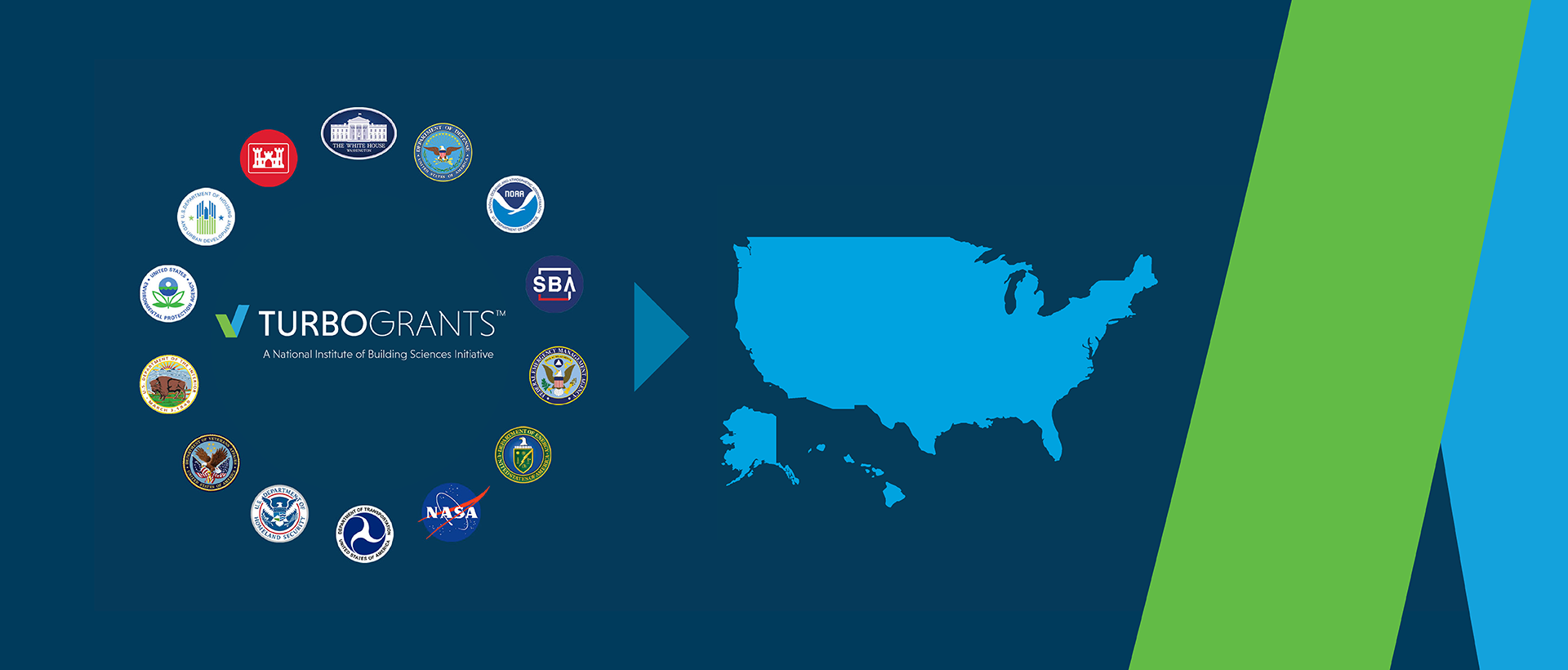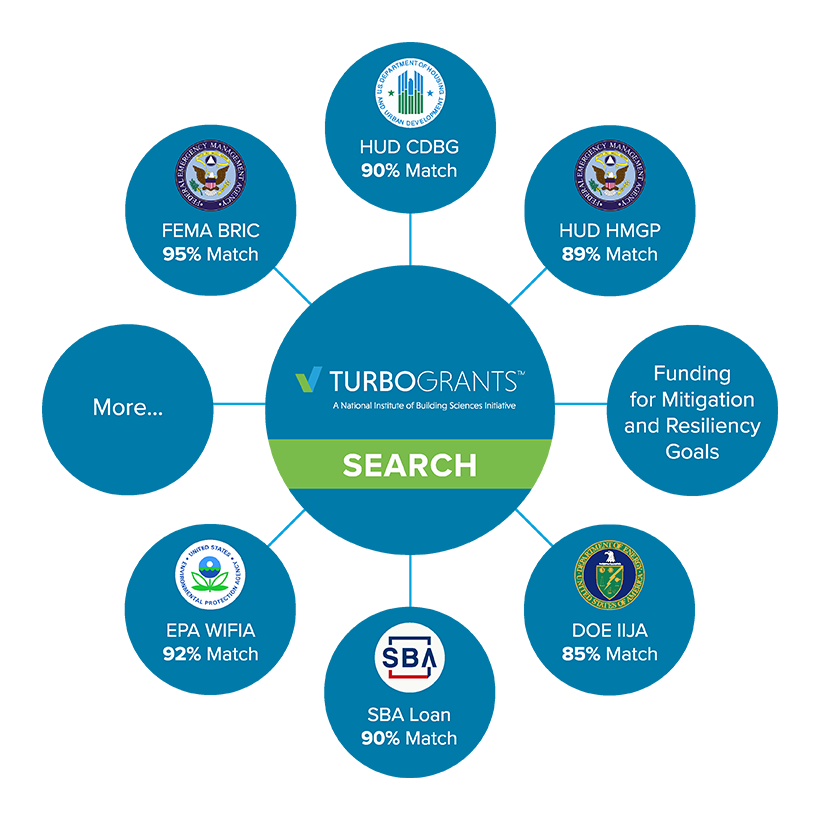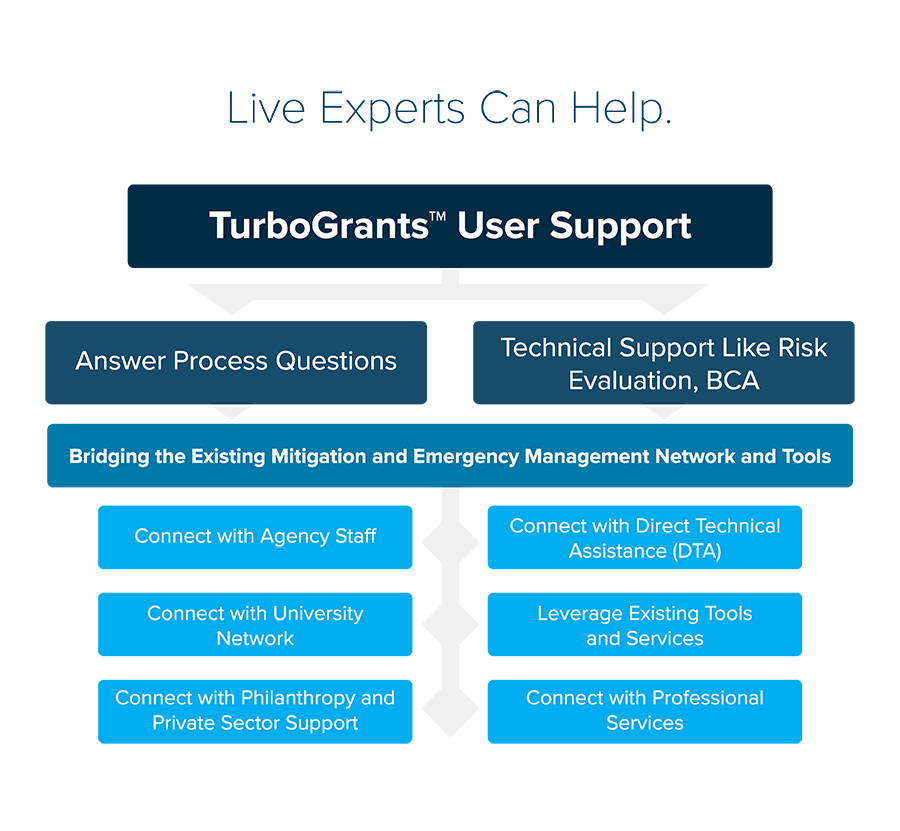
TurboGrants is a resilience one-stop shop that leverages technology to simplify the grant identification process, matches applicants with resources that fit their needs, and provides enhanced technical assistance. It's intended for anyone interested in applying for mitigation grants and funding. This may include state, local, tribal, and territorial (SLTT) governments, private nonprofits, businesses, academia, and individual homeowners. TurboGrants will integrate with existing federal and state tools to centralize access to mitigation grants available across federal agencies.

Match SLTTs with funding opportunities across all hazards and grants available across federal agencies.

Simplify, integrate, and collaborate with existing mitigation tools.

Build capacity, training, and 24/7 technical support.

Billions of dollars have been allocated across federal agencies to address the devastating effects of more frequent and severe weather events. However, many local and state governments struggle to efficiently access and use mitigation grant funds to build resilience due to:
Complicated grant processes
The NIBS Multi-Hazard Mitigation Council (MMC) asked over 400 emergency managers, state agency representatives, and other stakeholders about the difficulties they encounter when searching for federal funding resources. Respondents identified the following top challenges: don’t know where to begin; too many places to search; limited time and trained staff; navigating technical challenges, such as meeting benefit-cost analysis requirements; conflicting requirements across federal grants.
| Value | Percent |
|---|---|
| I don't know where to begin. | 25% |
| There are too many places to search. | 24% |
| I don't have the time or resources to pursue. | 37% |
| There are technical challenges like conducting a required benefit-cost analysis (cost effectiveness). | 47% |
| I cannot find a match for grants requiring cost shares or matches. | 33% |
| Grant deadlines do not coincide with our project. | 31% |
| There are few examples of what has worked and what has not worked. | 27% |
| Other, please specify: | 14% |
| I do not experience these difficulties. | 12% |
Unfair distribution of grant funds
Between 2010-2018, two-thirds of Federal Emergency Management Agency (FEMA) hazard mitigation grant funding went to just 3 states. Simultaneously, FEMA data indicates that every state experienced more disasters over a similar time period. Learn More
Largely unspent funding
Billions of dollars of mitigation funds are available but unspent across numerous federal grants. For example, over $9 billion in previously allocated FEMA Hazard Mitigation Grant Program funding remains unspent. Learn More
To address these challenges, TurboGrants is a novel solution that will leverage technology to simplify the grant identification process, match applicants’ needs with appropriate resources, and provide enhanced technical assistance to expedite resilience-building initiatives.

Grants Match
SLTTs can input their project details into the TurboGrants search engine to be matched with grants that meet their exact needs. TurboGrants will leverage geospatial mapping capabilities to identify historically marginalized and underserved communities eligible for prioritized investment through the Community Disaster Resilience Zones initiative and other equity-focused efforts.


Application
After being matched with appropriate grants, TurboGrants™ will allow users to apply for grant funds through an existing portal or direct users to federal portals to apply as a sub-applicant. TurboGrants™ User Support will bridge the gap to existing mitigation and emergency management tools to answer users’ process questions, connect with direct technical assistance (DTA), and provide risk evaluation + benefit-cost analysis (BCA) resources.

Technical Assistance

Future Vision
TurboGrants™ will cultivate a peer network that hosts webinars, workshops, and training modules for emergency managers and officials. The network will share project success stories and connect community leaders with similar mitigation needs.
Success stories and projects, and platform to connect community leaders working on similar projects.
TurboGrants Advisory Board
Bryan Koon, Chair
IEM
Russell Strickland, Vice Chair/MMC Board
Maryland Department of Emergency Management
Dr. Daniel Kaniewski, MMC Board
Marsh McLennan
Dr. Jiqiu (JQ) Yuan, Staff Lead
National Institute of Building Sciences
Curtis Brown, Resilience Advisor
National Institute of Building Sciences
Benjamin Ayers/Ali Al Momar, Member
U.S. Department of Housing and Urban Development
Dr. David Bray, Member
LeadDoAdapt (LDA) Ventures
Matt Cowles, Member
National Emergency Management Association
Natalie Enclade, Member
BuildStrong America
Judson Freed, Member
Ramsey County Emergency Management and Homeland Security
Rob Glenn, Member
U.S. Chamber of Commerce Foundation
Sam Medlock/Mike Godesky, Member
Federal Emergency Management Agency
Patrick Sheehan, Member
Tennessee Emergency Management
Carrie Speranza, Member
International Association of Emergency Managers
Annie Mack Vest, Member
Oklahoma Emergency Management
Contact
Jiqiu (JQ) Yuan, PhD, PE, PMP
Chief Resilience Officer & Head of Engineering
National Institute of Building Sciences
jyuan@nibs.org
Reports
-
 The MMC conducted a national survey to solicit feedback on the development of a National Mitigation Resource Portal.View (; 20 pgs)
The MMC conducted a national survey to solicit feedback on the development of a National Mitigation Resource Portal.View (; 20 pgs) -
 In 2020, the NIBS Committee on Finance, Insurance, and Real Estate (CFIRE) published A Roadmap to Resilience Incentivization, which calls for public and private incentives that allow owners of buildings and other infrastructure to facilitate the upgrade of existing infrastructure and better design of new infrastructure.View (; 150 pgs)
In 2020, the NIBS Committee on Finance, Insurance, and Real Estate (CFIRE) published A Roadmap to Resilience Incentivization, which calls for public and private incentives that allow owners of buildings and other infrastructure to facilitate the upgrade of existing infrastructure and better design of new infrastructure.View (; 150 pgs) -
 This document proposes to develop and demonstrate a set of public and private incentives to owners of buildings and other infrastructure to facilitate the upgrade of existing infrastructure and better design of new infrastructure.View (; 33 pgs)
This document proposes to develop and demonstrate a set of public and private incentives to owners of buildings and other infrastructure to facilitate the upgrade of existing infrastructure and better design of new infrastructure.View (; 33 pgs) -
 The Natural Hazard Mitigation Saves: 2019 Report represents the most exhaustive benefit-cost analysis of natural hazard mitigation, from adopting up-to-date building codes and exceeding codes to addressing the retrofit of existing buildings and utility and transportation infrastructure.View (; 619 pgs)
The Natural Hazard Mitigation Saves: 2019 Report represents the most exhaustive benefit-cost analysis of natural hazard mitigation, from adopting up-to-date building codes and exceeding codes to addressing the retrofit of existing buildings and utility and transportation infrastructure.View (; 619 pgs)




